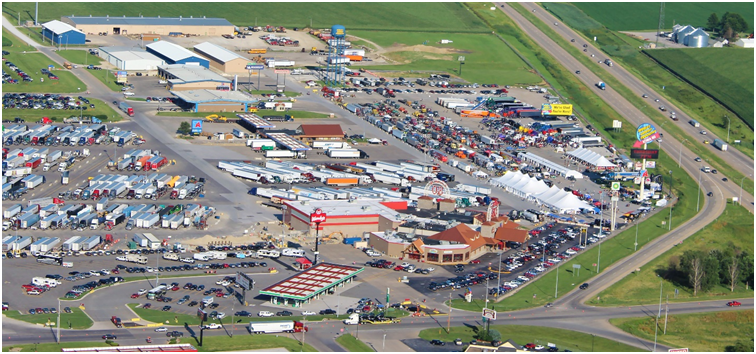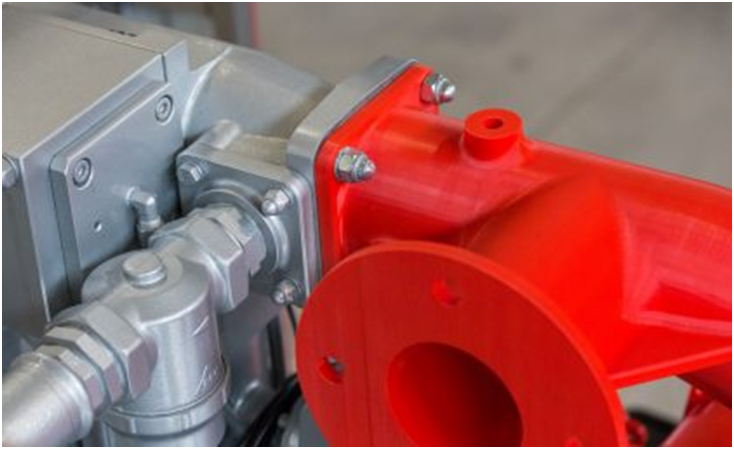
Charles Goulding and Peter Favata hit the road with an idea for spare parts 3D printing that keeps truckers trucking.
Major highway truck stops have been around since the 1920s and the industry has been growing ever since. Today the U.S. highways are covered with thousands of truck stops with many different amenities. Some of these range from places to rest while truckers sleep in their cab, to gathering hubs offering multiple options for food, laundry, convenience centers, entertainment centers, as well as showers and hotel rooms if they need a place to relax for a night. With fewer people traveling, you would think that these stops are getting less traffic but it is quite the opposite. This comes from the increased eCommerce putting more truckers on the road.
The Truck Stop Big Three
TravelCenters of America Inc. is the largest publicly traded owner of truck stops and has seen shares grow 50% since reporting quarterly results in August 2020. The largest owner of truck stops is Pilot Co., which operates over 750 truck stops. Pilot Co. also is backed by Warren Buffett’s Berkshire Hathaway who owns a 38.6% stake and is looking to increase that to an 80% interest in 2023. Loves Travel Stops & Country Stores, based out of Oklahoma City, is the second-largest chain of truck stops in the country is also doing very well with 510 locations in 41 states, with an estimated annual revenue of $20 billion.
3D Printing Opportunities
3D printing is a very versatile tool that these truck stops could be taking advantage of. It is already starting to be utilized in the manufacturing process for truck parts.
One of the major uses for truck stops is a place to stop if a truck breaks down or needs minor maintenance such as a small part replacement or a tire repair. These truck stops could utilize 3D printing to produce small replacement parts and repair the truck to get them back on the road as quickly as possible. These just-in-time parts are especially useful if a trucker is on a short timeline for a job and does not have time to wait for a full repair job, they can use the 3D printed replacement part to finish the job and later go to their companies mechanic to have the part replaced permanently. Another advantage of being able to 3D print parts is they eliminate inventory storage space.

Manufactures and technical designers utilizing 3D printing in the truck part industry may be eligible for R&D Tax Credits.
The Research & Development Tax Credit
Whether it’s used for creating and testing prototypes or for final production, 3D printing is a great indicator that R&D credit-eligible activities are taking place. Companies implementing this technology at any point should consider taking advantage of R&D Tax Credits.
Enacted in 1981, the now permanent Federal Research and Development (R&D) Tax Credit allows a credit that typically ranges from 4%-7% of eligible spending for new and improved products and processes. Qualified research must meet the following four criteria:
- Must be technological in nature
- Must be a component of the taxpayer’s business
- Must represent R&D in the experimental sense and generally includes all such costs related to the development or improvement of a product or process
- Must eliminate uncertainty through a process of experimentation that considers one or more alternatives
Eligible costs include US employee wages, cost of supplies consumed in the R&D process, cost of pre-production testing, US contract research expenses, and certain costs associated with developing a patent.
On December 18, 2015, President Obama signed the PATH Act, making the R&D Tax Credit permanent. Since 2016, the R&D credit can be used to offset Alternative Minimum Tax (AMT) or companies with revenue below $50MM and, startup businesses can obtain up to $250,000 per year in cash rebates that can be applied directly to payroll taxes.
Conclusion
The truck stop industry is a large growing business sector. By implementing 3D printing they can get our truckers back on the road as quickly and efficiently as possible.

Remember a few years back when Berkshire Hathaway invested heavily in truck stops?
https://www.reuters.com/article/us-pilotflyingj-m-a-berkshirehathaway-idUSKCN1C81C0
RVs are another area where I have helped folks out with custom parts. In 2008, the RV industry was devastated with many of the mom and pop tooling shops closing. It can be easy to address a broken RV part with 3D printing (especially since there may be no other alternative in the market).